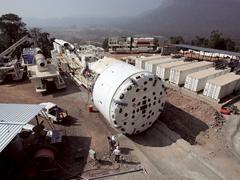
|
Feb 16, 2011
News
The Robbins Company
First Laotian TBM rallies for a Successful Finish
|
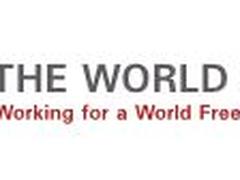
|
Mar 02, 2011
News
The World Bank
The World Bank Board of Directors today approved a US$15 million grant to help Haiti’s efforts to fight the cholera epidemic.
|
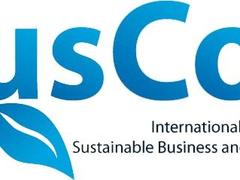
|
3rd SusCon – International Conference on Sustainable Business and Consumption on 28/29 June 2011, in Nuremberg
|
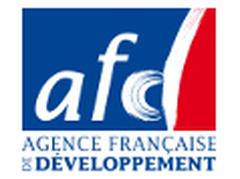
|
Mar 10, 2011
News
AFD (Agence française de Développement)
This platform is open to all actors concerned by public water services and aims to improve drinking water supply services in small towns in developing countries.
|

|
Mar 16, 2011
News
Asian Development Bank
The Asian Development Bank's (ADB's) Board of Directors has approved a $1 billion financial support facility that will help improve clean water access for three million families in Viet Nam, including half a million poor households who will receive their own piped water connection for the first time.
|
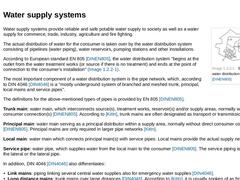
|
(Image: Example of a water distribution system [DINEN805]) Water supply systems provide reliable and safe potable water supply to society as well as a water supply for commerce, trade, industry, agriculture and fire fighting. The actual distribution of water for the consumer is taken over by the water distribution system consisting of pipelines (water piping), water reservoirs, pumping stations and other installations. According to European standard … |
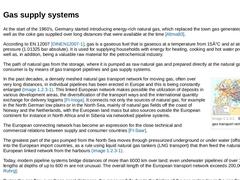
|
At the start of the 1960's, Germany started introducing energy-rich natural gas, which replaced the town gas generated from coal as well as the coke gas supplied over long distances that were available at the time [Altma83]. According to EN 12007 [DINEN12007-1], gas is a gaseous fuel that is gaseous at a temperature from 15°C and at atmospheric pressure (1.01325 bar absolute). It is used for supplying households with energy for heating, cooking and … |
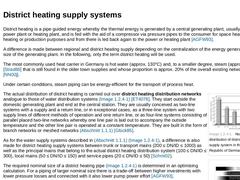
|
District heating is a pipe guided energy whereby the thermal energy is generated by a central generating plant, usually a steam power plant or heating plant, and is fed with the aid of a compressor via pressure pipes to the consumer for space heating, hot water heating or production purposes and from there is led back again to the power or heating plant [AGFW93]. A difference is made between regional and district heating supply depending on the centralization … |
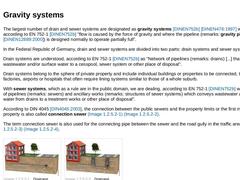
|
The largest number of drain and sewer systems are designated as gravity systems [DINEN752b] [DINEN476:1997] where, according to EN 752-1 [DINEN752b] "flow is caused by the force of gravity and where the pipeline (remarks: gravity pipe [DINEN12889:2000]) is designed normally to operate partially full". In the Federal Republic of Germany, drain and sewer systems are divided into two parts: drain systems and sewer systems. Drain systems are understood, … |
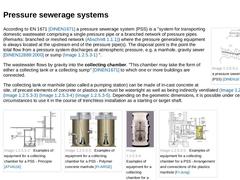
|
(Image: Arrangement of a pressure sewerage system (PSS) [DINEN1671]) According to EN 1671 [DINEN1671] a pressure sewerage system (PSS) is a "system for transporting domestic wastewater comprising a single pressure pipe or a branched network of pressure pipes (Remarks: branched or meshed network (Abschnitt 1.1.1)) where the pressure generating equipment is always located at the upstream end of the pressure pipe(s). The disposal point is the point the … |
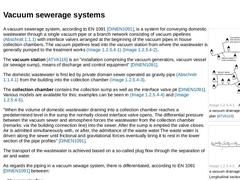
|
| (Image: Arrangement of a vacuum drainage system - Site plan [ATVA116]) | | (Image: Arrangement of a vacuum drainage system - Longitudinal section [DINEN1091]) | | (Image: Diagram of a house connection in a vacuum drainage system [DINEN1091]) | | (Image: Forms of collecting chambers [DINEN1091] - With sump capacity provided in feed pipework) | | (Image: Forms of collecting chambers [DINEN1091] - With separate collection chamber and valve pit) |
A vacuum sewerage … |
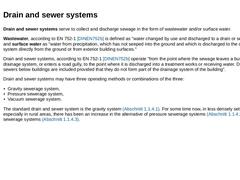
|
Drain and sewer systems serve to collect and discharge sewage in the form of wastewater and/or surface water. Wastewater, according to EN 752-1 [DINEN752b] is defined as "water changed by use and discharged to a drain or sewer system" and surface water as "water from precipitation, which has not seeped into the ground and which is discharged to the drain or sewer system directly from the ground or from exterior building surfaces." Drain and sewer systems, … |

|
Telecommunication (TC) is the exchange of messages and information in the form of tones, pictures, text or data over larger distances to end devices such as telephones, television, fax or data processing devices (e.g. computers). Broadband communication (BC) is a generic term for those forms of telecommunication, which, because of the quantity of information to be transmitted per unit of time, require a relatively large frequency land (mostly several … |
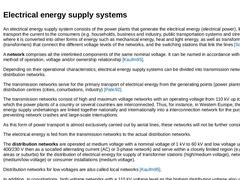
|
An electrical energy supply system consists of the power plants that generate the electrical energy (electrical power), lines that transport the current to the consumers (e.g. households, business and industry, public transportation systems and street lighting), where it is converted into other forms of energy such as mechanical energy, heat and light energy, as well as transformer stations (transformers) that connect the different voltage levels … |
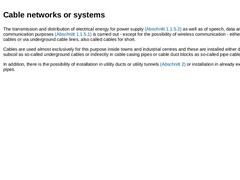
|
The transmission and distribution of electrical energy for power supply (Abschnitt 1.1.5.2) as well as of speech, data and pictures for communication purposes (Abschnitt 1.1.5.1) is carried out - except for the possibility of wireless communication - either via overhead cables or via underground cable lines, also called cables for short. Cables are used almost exclusively for this purpose inside towns and industrial centres and these are installed … |
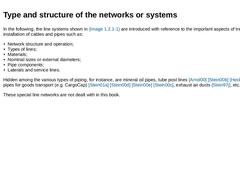
|
In the following, the line systems shown in Bild 1 are introduced with reference to the important aspects of trenchless installation of cables and pipes such as: - Network structure and operation;
- Types of lines;
- Materials;
- Nominal sizes or external diameters;
- Pipe components;
- Laterals and service lines.
Hidden among the various types of piping, for instance, are mineral oil pipes, tube post lines [Arnol00] [Stein00b] [Heck65] transport pipes for goods … |
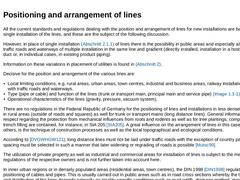
|
All the current standards and regulations dealing with the position and arrangement of lines for new installations are based on the single installation of the lines, and these are the subject of the following discussion. However, in place of single installation (Abschnitt 2.1.1) of lines there is the possibility in public areas and especially at crossings of traffic roads and waterways of multiple installation in the same line and gradient (directly … |
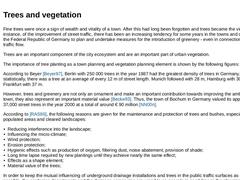
|
Fine trees were once a sign of wealth and vitality of a town. After this had long been forgotten and trees became the victim, for instance, of the improvement of street traffic, there has been an increasing tendency for some years in the towns and communities of the Federal Republic of Germany to plan and undertake measures for the introduction of greenery - even in connection with easing traffic flow. Trees are an important component of the city … |
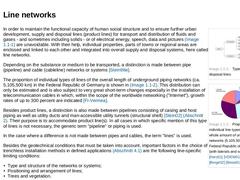
|
| (Image: Types of supply and disposal lines) | | (Image: Proportion of individual line types (in km) of the whole amount of underground networks (5.105.500 km) in the Federal Republic of Germany (with laterals and service lines [Herz01] [VDEW01] [FI-Telek01] [Berge02] [Besie01])) |
In order to maintain the functional capacity of human social structure and to ensure further urban development, supply and disposal lines (product lines) for transport and … |
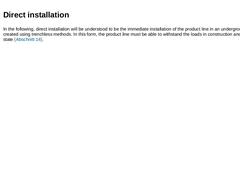
|
In the following, direct installation will be understood to be the immediate installation of the product line in an underground cavity created using trenchless methods. In this form, the product line must be able to withstand the loads in construction and operation state (Abschnitt 14). |
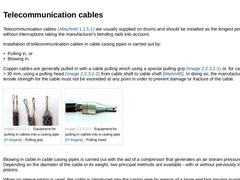
|
Telecommunication cables (Abschnitt 1.1.5.1) are usually supplied on drums and should be installed as the longest possible string without interruptions taking the manufacturer's bending radii into account. Installation of telecommunication cables in cable casing pipes is carried out by: - Pulling in, or
- Blowing in.
Copper cables are generally pulled in with a cable pulling winch using a special pulling grip (Bild 2.1.2.1) or, for cable diameters > 30 … |
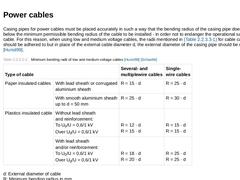
|
Casing pipes for power cables must be placed accurately in such a way that the bending radius of the casing pipe does not fall below the minimum permissible bending radius of the cable to be installed - in order not to endanger the operational safety of the cable. For this reason, when using low and medium voltage cables, the radii mentioned in Tabelle 2.1.2.2 for cable casing pipes, should be adhered to but in place of the external cable diameter … |
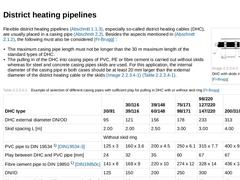
|
(Image: Pulling in a DHC with skids in a casing pipe [FI-Brugg]) Flexible district heating pipelines (Abschnitt 1.1.3), especially so-called district heating cables (DHC), are usually placed in a casing pipe (Abschnitt 2.2). Besides the aspects mentioned in Abschnitt 2.1.2, the following must also be considered [FI-Brugg] : - The maximum casing pipe length must not be longer than the 30 m maximum length of the standard types of DHC.
- The pulling in of …
|
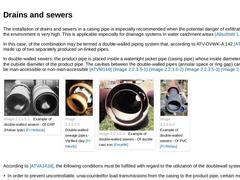
|
The installation of drains and sewers in a casing pipe is especially recommended when the potential danger of exfiltrating sewage to the environment is very high. This is applicable especially for drainage systems in water catchment areas (Abschnitt 1.1.4.1). In this case, of the combination may be termed a double-walled piping system that, according to ATV-DVWK-A 142 [ATVA142d] is made up of two separately produced un-linked pipes. In double-walled … |
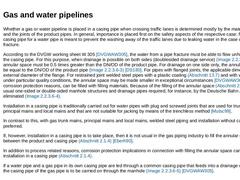
|
Whether a gas or water pipeline is placed in a casing pipe when crossing traffic lanes is determined mostly by the materials used and the joints of the product pipes. In general, importance is placed first on the safety aspects of the respective case; for instance, a casing pipe for a water pipe is meant to prevent the washing away of the traffic lanes due to leaking water in the case of a pipe fracture. According to the DVGW working sheet W 305 [… |